
Graphic by Louise Nillas | Mercury Staff.
New platform to allow access to emergency services without placing phone calls
By the summer of
2019, residents of Plano will be able to text their 911 call center.
The software upgrade will cost the city upwards of $350,000. The funding
was first approved by the city council on Feb. 11, said Susan Rodriguez, a
public information specialist for Plano Public Safety.
“The text to 911
system has been in the works for a while, but there are only so many tech
projects the city can handle at one time,” Rodriguez said. “It was proposed by the 911 center itself,
but they have to go through a pretty strenuous process to get it on the
budget.”
Text to 911 is still not available in many areas across North Texas,
including parts of Collin and Dallas County. However, other large cities such
as Houston and San Antonio do have the technology.
Rodriguez said
the existing 911 infrastructure, which was built in 1968, is based on
traditional landline technology.
“It takes a lot
of funding to renovate it, which is the main reason the texting system is not
yet widespread,” she said.
Currently, people who are deaf or hard of hearing use a TTY, which is a
telecommunication device for the deaf.
It is a keyboard with an attached phone that allows for text
communication over a phone line. The message is transcribed onto a teleprinter
at the 911 call center or shows up on a digital monitor.
“I think this is
a move in the right direction,” said Milind Wadhwa, a finance junior and Plano
resident. “There are so many dangerous situations where talking out loud can
just make it worse. This will prevent that from happening.”
Kortney Sorrell,
a community outreach coordinator for The Turning Point Rape Crisis Center, said
the new 911 system will be especially useful for sexual assault and domestic
violence cases. Perpetrators may become aggressive if they hear the victims
talking, she said.
“Overall, I think that victims of
sexual assault and anything related to trafficking and domestic violence will
all find this very useful,” Sorrell said. “The only downside is that only the
big carriers like T-Mobile, Sprint, AT&T and Verizon will support it.
People (who) either have a prepaid cell phone or don’t have a major carrier
can’t take advantage of the service.”
Once a
911 call center requests the text to 911 feature, the cellular
providers in the area have six months to make the feature available to their
customers. If someone tries to text a call center where the service is
unavailable, the Federal Communications Commission requires that cellular
providers send a bounce-back message advising users to contact 911 by calling.
“The
handling of the texts will be similar to how we deal with deaf callers now. The
texts will show up on a machine, and that’s how we will communicate,” Rodriguez
said. “The younger generation has definitely embraced the cell phone more than
the TTY.”
Rodriguez said though the new text-to-911 feature will add
convenience for some users, a phone call is still the preferred method of
contacting emergency services.
“We can
glean a lot from the background noise of a call and the way a person speaks on
the phone,” she said. “In addition, we cannot pinpoint an exact location based
on a cell phone, but we can from a landline.”